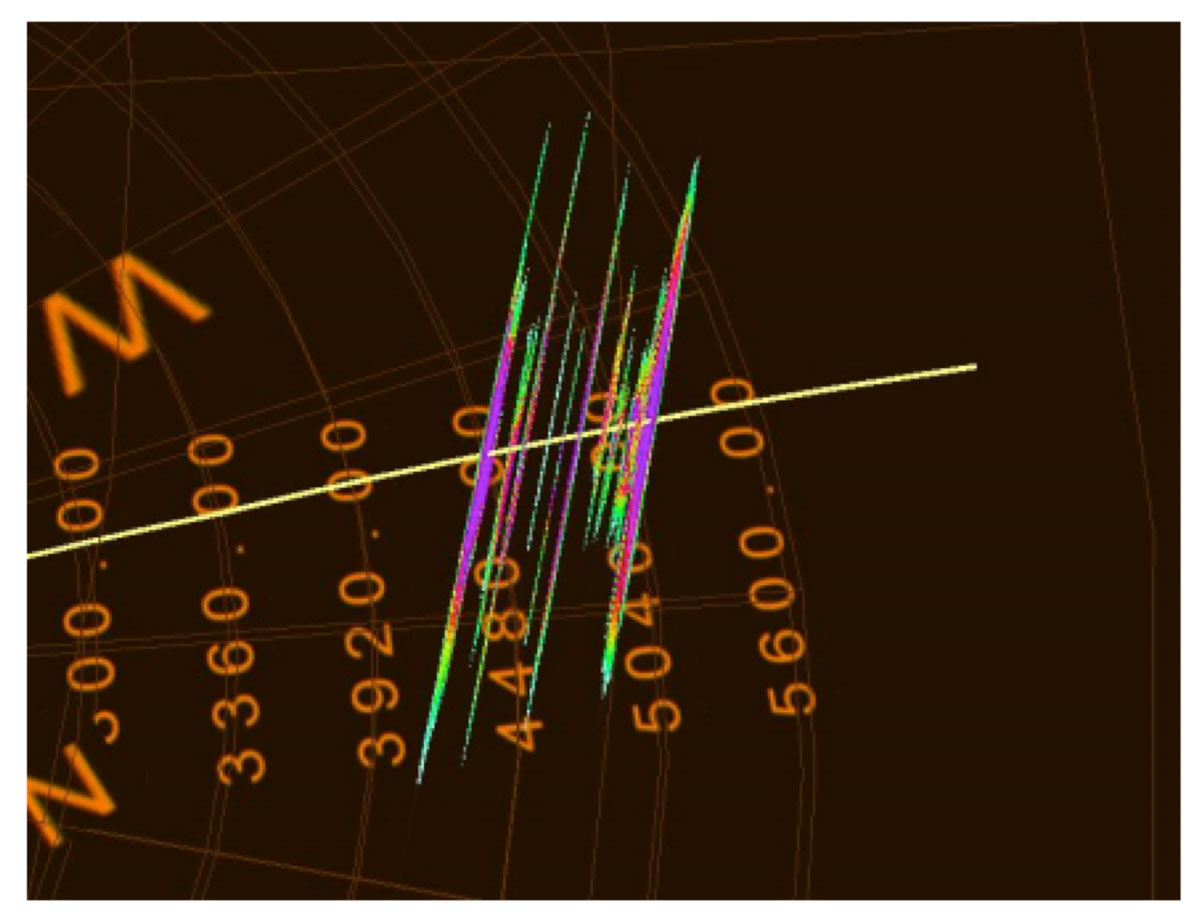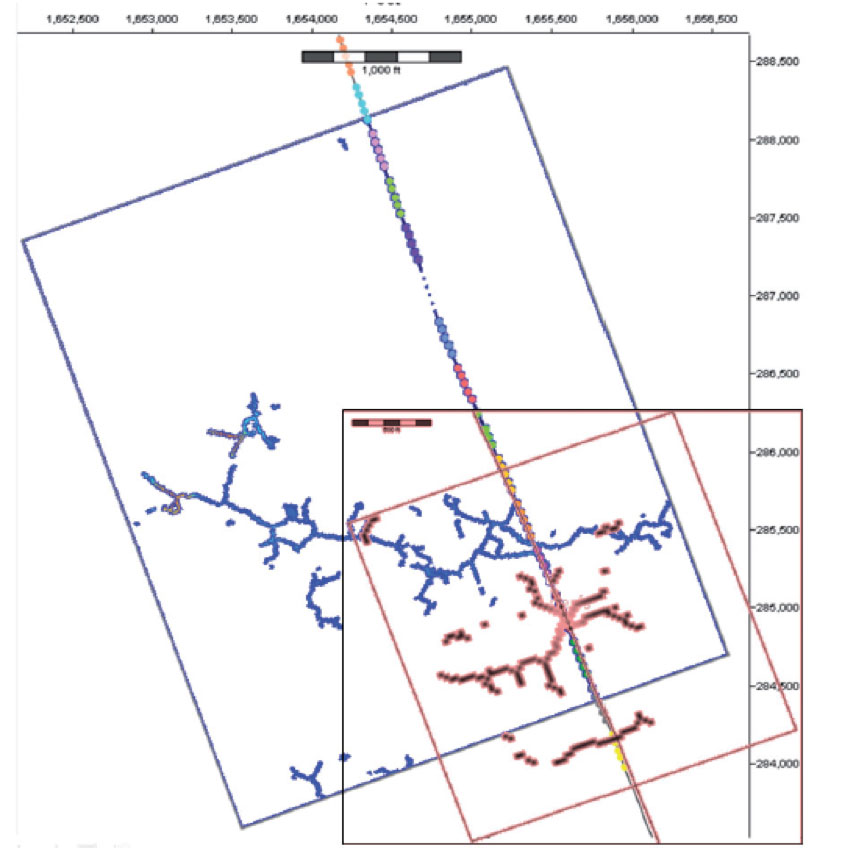A deeper understanding of geomechanics is critical in understanding reservoir behaviors, from rock mechanics to fluid flow. Welcome to an interview with Dr. Amy Fox, Enlighten Geoscience, who talks to us today about some of the ways in which geomechanics adds value.

GOHFER output for non-orthogonal interfering fractures. Plan view looking down on the two stages (ten total clusters).
A deeper understanding of geomechanics is critical in understanding reservoir behaviors, from rock mechanics to fluid flow. Welcome to an interview with Dr. Amy Fox, Enlighten Geoscience, who talks to us today about some of the ways in which geomechanics adds value.
What is your name and your relation to geology and geophysics?
My name is Amy Fox (though I have some past publications under the surname Day-Lewis). I discovered geophysics while I was a geology major in college. I was at the University of New Hampshire, so the geophysics courses there focused on environmental and near-surface techniques. I became very interested in using geophysics in archaeology, but this was at a time when geophysical tools (for example, ground-penetrating radar) were becoming user-friendly enough that the archaeologists didn't feel that they needed geophysicists in order to use them or understand the results, so that never really went anywhere. Then I found myself in graduate school in the geophysics department at Stanford University, where the focus was generally on one of two topics, depending on which group you were in, earthquakes or hydrocarbons. It was a big change for me, but I ended up developing an interest in geomechanics, and now I've been working in that field for nearly 20 years.
What is, in your opinion, the core value of geomechanics?
Geomechanics is all about understanding the interplay between physics and geology. In oil and gas, geomechanics can be incredibly helpful and valuable in a number of ways, the relative importance of which has changed over time as the industry has changed. When I started out in the late 1990's, most of the work I did was on wellbore stability studies to reduce drilling costs and risks. Today, while wellbore stability remains as important as ever, you see a big focus on hydraulic fracturing. One unfortunate aspect of geomechanics, one that I have not seen change much over the years, is that it is routinely ignored until there are major problems; it's considered a "nice to have" rather than a necessary part of planning a well or developing a production strategy. Geomechanics is almost never built into the drilling and completion budget, so "extra" money is needed to get any work done. I would love to see this attitude change.
How can geomechanics be helpful in understanding frac interference?

Relationship between induced fractures created by the frac stage (brown) shown in figure 11 and natural fairway (figure 10 and in blue in this figure) activated by the stage.
"Stress shadowing," "frac hits" and other buzzwords these days refer to consequences of the physics of hydraulic fracturing. The use of the hydraulic fracturing technique grew so quickly over the past ten or so years that the geomechanics discipline has struggled to keep up. Our early models were for single fracs in vertical wells, but today we drill long horizontal wells with dozens of frac stages often placed as closely together as possible. Only recently have sophisticated models started becoming available to understand the physics of such complicated operations. That said, even though appropriate models are now available, they won't provide correct results if the user doesn't understand the geomechanical inputs and calculation options. I would argue that using a hydraulic fracture model with default inputs and incorrect in situ stresses is probably no better than having no model at all.
How is passive seismic used with geomechanics?
I have not had the opportunity to work directly with passive seismic or microseismic data, but of course a number of my colleagues have, and from them I've learned some really fascinating things. For example, a few years ago Global Geophysical published some papers on what they were calling fracture tomography, using microseismic during hydraulic fracture treatments to delineate natural fracture networks away from the stimulated well. They were looking at later events at a greater distance from the well than would normally be analyzed to try to map the induced hydraulic fractures, and these events were distinguished from noise because they occurred repeatedly during subsequent stage treatments. In some cases the same kind of fracture mapping can be done using passive seismic surface arrays. This kind of information can be used to understand hydraulic communication between wells or frac stages through natural fracture pathways.
How is geomechanics used to develop more accurate reservoir models?
Reservoir models traditionally don't involve geomechanics beyond including significant faults or structures in various ways. In the past, efforts to simulate reservoirs and include geomechanics have needed to basically run two models iteratively – the reservoir model feeding information to a geomechanical model, which then does its work and passes back the new geomechanical information (stresses, pressures, rock properties, etc.) to the reservoir model, and the data swapping continues like that. I have not seen personally any truly coupled reservoir/geomechanical models, although it looks like they are emerging from either universities or companies that invest heavily in R&D. I suppose there needs to be a big enough market for such models for industry to invest in developing them, and in the end they are inevitably quite expensive to the consumer. That said, many reservoir processes, particularly the implications for injecting (e.g. hydraulic fracturing, steam-flooding) or producing fluids can only really be understood by including geomechanics.
Do you have any plans for the future?
Of course! Besides continuing with consulting for my oil and gas clients, I'm working with my partner at Enlighten Geoscience to build regional geological and geomechanical studies of various plays. I was first introduced to the concept after moving to Canada in 2011. Here all well data is available to the public through the provincial energy regulators. As a result, there is a ton of data available, and this includes geomechanical data that hardly anyone has ever looked at. To me it's a goldmine of information. In 2013-2014 I was involved in using this data to do a regional geomechanical study of the Duvernay formation, and although data was limited due it being very early stages in development of the play, some good insights came out of the work. We plan on doing similar work for the Upper Mannville, the East Shale Basin Duvernay (a different play entirely from the main Duvernay) and Northern Montney. I'm also constantly updating teaching materials to introduce people in other disciplines to geomechanics, and I volunteer with organizations like SPE and the Canadian Society of Petroleum Engineers.